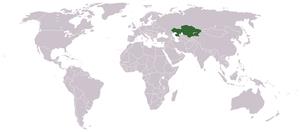The history of Kazakhstan describes the human past in the Eurasia's largest segment of the steppe belt that was the home and crossroads for numerous human groups starting with extinct Pithecanthropus and Sinanthropus 1 mln – 800,000 in the Karatau Mountains, Caspian and Balkhash areas; Neanderthals 140 – 40 thousand years ago in the Karatau Mountains and Central Kazakhstan, and the arrival of the modern Homo Sapiens 40 – 12 thousand years ago in the Southern, Central, and Eastern Kazakhstan. After the end of the Last glacial period, 12.5 – 5 thousand years ago campsites spread across the whole of Kazakhstan, eventually leading to extinction of large animals (mammoth, woolly rhinoceros). The hunter-gatherer communes invented bow and boats, and used domesticated wolf and traps for hunting, developed Atbasar archeological culture.Around 5 thousand years ago in the process of Neolithic Revolution appeared animal husbandry and agriculture, which formed the Atbasar, Kelteminar, Botai, Mokanjar, Ust-Narym, and other archeological cultures. The Botai culture (3600–3100 BCE) is credited with the first domestication of horses. In the course of the Neolithic Revolution. ceramics and polished stone tools appeared, found spread across Kazakhstan steppes, river valleys, and mountains. The 4th – 3rd millenniums witnessed the beginning of metal production, manufacture of copper tools, and use of casting molds. Up to 100 sites were found with copper casting shops. In the 2nd millennium, ore mining developed in Central Kazakhstan, pastoral animal husbandry appeared and spread, and horse nomadic economy became a developed technology as a viable production method in the Eurasian steppes.The change of climatic conditions forced massive relocations of populations in and out of the steppe belt. The aridization period that lasted for a millennium from the end of the 2nd millennium to the beginning of the 1st millennium BCE caused depopulation of the arid belts and river valley oasis areas, their population moved north to the forest-steppe zone. New populations migrated in with the end of the arid period in the beginning of the 1st millennia BCE, repopulating abandoned areas by inflows from the west and from the east, creating symbiotic societies that started forming in the 7th century BCE.In the 3rd century BCE the arising Hunnic Empire covered the whole of Kazakhstan among its territories, starting the Kazakhstan historical period. Soon after its creation,the Hunnic Empire absorbed 26 independent possessions, uniting various steppe and forest peoples into a single state. After the demise of the Eastern Hunnic Empire, the Tele people of Kazakhstan, known in Chinese annals as Tiele, formed tribal unions that became a coveted attraction for the Hunnic successors, but they generally retained independence of their unions. In the 6th century CE the people of Kazakhstan were again absorbed into the new political state, the Turkic Kaganate, that controlled approximately the same area as the Eastern Hunnic Empire. Subsequently, large portions of Kazakhstan were ruled in sequence by the Uigur and Kirgiz Kaganates.During the Early Middle Ages, a number of independent states also flourished in Kazakhstan, the best known being Kangar union, Oghuz Yabgu State, and Kara-Khanid Kaganate. In the 13th century Kazakhstan fell into a dominion of the Mongol Empire, and remained in the sphere of the Mongol successor states till the New Time. Starting in the 16th century parts of Kazakhstan were annexed by the Russian Empire, and what remained was gradually absorbed into Russian Turkestan, starting in 1867. The modern Republic of Kazakhstan was separated into a new political entity during the Soviet subdivision of the Russian Turkestan in the 1930s.




Comment
0